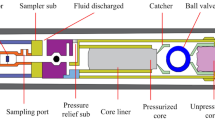Abstract
A new sampling method of deepsea microplankton with function of in-situ concentrated sampling and gastight sampling was proposed. In-situ concentrated sampling technique was realized as follows: a microplankton membrane was used as filtration membrane, and a deepsea pump was used to pump seawater; the microplankton was captured and the density of microplankton was increased when seawater flow through the filtration membrane. Gastight sampling technique was realized as follows: a precharged accumulator was used as pressure compensator. During the process of lifting the sampler, the accumulator compensated the pressure drop continuously. The laboratory experimental results show that with in-situ concentrated sampling technique, in-situ concentrated sampling can be realized and the maximum concentration ratio reaches up to 500. With pressure compensation technique based on accumulator, gastight sampling can be realized. When sampling at 6 km and the precharge pressure of accumulator is 18 MPa, pressure drop of the sample is less than 2% compared with its original pressure. Deepsea experiment (at 1.9 km) results show that the sampler can realize in-situ concentrated sampling and gastight sampling.
Similar content being viewed by others
References
CHEN **u-lan, ZHANG Yu-zhong, GAO Pei-ji. Progress in deepsea microbiology[J]. Marine Sciences, 2004, 28(1): 62–67. (in Chinese)
LI Shi-lun, ZHANG Jian-wen, YE Shu-ming, et al. Temperature control system for the simulation platform of culturing deepsea microbes[J]. Ocean Engineering, 2004, 22(3): 92–96. (in Chinese)
XIAO Tian, CHEN Ma. Microbial processes at deep sea hydrothermal vents[J]. Marine Sciences, 1998, 22(6): 11–15. (in Chinese)
HU Wen-xuan, ZHOU Huai-yan, GU Liang-xin. New proof on microbe formed deepsea manganese nodule[J]. China Science (D Edition), 1999, 29(4): 362–368. (in Chinese)
XI Feng, ZHENG Tian-ling, JIAO Nian-zhi, et al. A preliminary analysis of mechanism of deep sea microorganisms diversity[J]. Advance in Earth Sciences, 2004, 19(1): 38–46. (in Chinese)
JACOBS P H. A new rechargeable dialysis pore water sampler for monitoring sub-aqueous in-situ sediment caps[J]. Water Research, 2002, 36: 3121–3129.
DIMEO C A, WAKEFIELD J R, CRAIG C S. A new device for sampling small volumes of water from marine micro-environments[J]. Deep-Sea Research I, 1999, 46: 1279–1287.
BIANCHI A, GARCIN J, THOLOSAN O. A high-pressure serial sampler to measure microbial activity in the deep sea[J]. Deep-Sea Research I, 1999, 46: 2129–2142.
HUANG Zhong-hua, LIU Shao-jun, SHEN Hai-kuo, et al. Control system design of autonomic deepsea plankton sampler with concentrated and fidelity function[J]. Ocean Engineering, 2006, 24(1): 128–131. (in Chinese)
GADALA M S. Recent advances in the numerical modeling of constitutive relations[J]. Finite Elements in Analysis and Design, 1997, 24(3): 171–185.
SHANGGUAN Wen-bin, LU Zhen-hua. Modelling of a hydraulie engine mount with fluid-structure interaction finite element analysis[J]. Journal of Sound and Vibration, 2004, 5(1): 193–221.
HUSNU D M, ESRA A. Computer aided modelling of flexible forming process[J]. Journal of Materials Processing Technology, 2004, 148(3): 376–381.
BANKS H T, PINTER G A, YEOH O H. Analysis of bonded elastic blocks[J]. Mathematical and Computer Modelling, 2002, 36(7): 875–888.
HUANG Zhong-hua, JIN Bo, LIU Shao-jun, et al. Quick plenum process of bladder accumulator[J]. Journal of Central South University: Science and Technology, 2006, 37(2): 306–309. (in Chinese)
HUANG Zhong-hua, LIU Shao-jun, JIN Bo. Isobaric technique based on accumulator for deepsea microbe sampling[J]. China Ocean Engineering, 2006, 20(2): 335–342.
Author information
Authors and Affiliations
Corresponding author
Additional information
Foundation item: Project(DY105-03-01-10) supported by China Ocean Mineral Resources Research and Development Association; Project (1343-75221) supported by Central South University
Rights and permissions
About this article
Cite this article
Huang, Zh., Liu, Sj., **, B. et al. Concentrated and gastight sampling technique of deepsea microplankton. J. Cent. South Univ. Technol. 14, 820–825 (2007). https://doi.org/10.1007/s11771-007-0156-3
Received:
Accepted:
Published:
Issue Date:
DOI: https://doi.org/10.1007/s11771-007-0156-3




